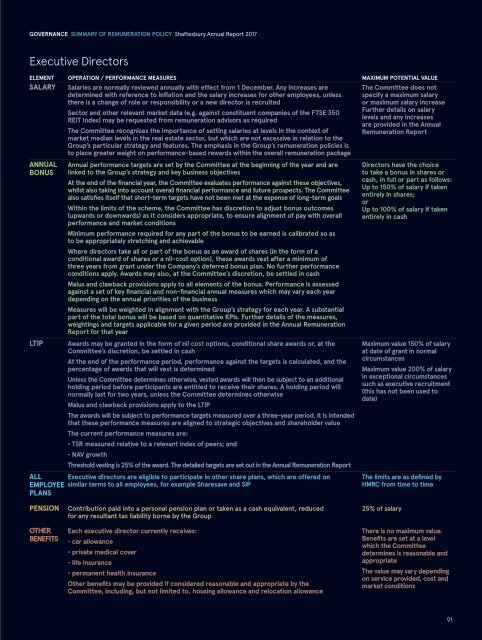Shaftesbury AR 2017 LR
Create successful ePaper yourself
Turn your PDF publications into a flip-book with our unique Google optimized e-Paper software.
GOVERNANCE SUMM<strong>AR</strong>Y OF REMUNERATION POLICY <strong>Shaftesbury</strong> Annual Report <strong>2017</strong><br />
Executive Directors<br />
ELEMENT OPERATION / PERFORMANCE MEASURES MAXIMUM POTENTIAL VALUE<br />
SAL<strong>AR</strong>Y Salaries are normally reviewed annually with effect from 1 December. Any increases are<br />
determined with reference to inflation and the salary increases for other employees, unless<br />
there is a change of role or responsibility or a new director is recruited<br />
ANNUAL<br />
BONUS<br />
LTIP<br />
Sector and other relevant market data (e.g. against constituent companies of the FTSE 350<br />
REIT Index) may be requested from remuneration advisors as required<br />
The Committee recognises the importance of setting salaries at levels in the context of<br />
market median levels in the real estate sector, but which are not excessive in relation to the<br />
Group’s particular strategy and features. The emphasis in the Group’s remuneration policies is<br />
to place greater weight on performance-based rewards within the overall remuneration package<br />
Annual performance targets are set by the Committee at the beginning of the year and are<br />
linked to the Group’s strategy and key business objectives<br />
At the end of the financial year, the Committee evaluates performance against these objectives,<br />
whilst also taking into account overall financial performance and future prospects. The Committee<br />
also satisfies itself that short-term targets have not been met at the expense of long-term goals<br />
Within the limits of the scheme, the Committee has discretion to adjust bonus outcomes<br />
(upwards or downwards) as it considers appropriate, to ensure alignment of pay with overall<br />
performance and market conditions<br />
Minimum performance required for any part of the bonus to be earned is calibrated so as<br />
to be appropriately stretching and achievable<br />
Where directors take all or part of the bonus as an award of shares (in the form of a<br />
conditional award of shares or a nil-cost option), these awards vest after a minimum of<br />
three years from grant under the Company’s deferred bonus plan. No further performance<br />
conditions apply. Awards may also, at the Committee’s discretion, be settled in cash<br />
Malus and clawback provisions apply to all elements of the bonus. Performance is assessed<br />
against a set of key financial and non-financial annual measures which may vary each year<br />
depending on the annual priorities of the business<br />
Measures will be weighted in alignment with the Group’s strategy for each year. A substantial<br />
part of the total bonus will be based on quantitative KPIs. Further details of the measures,<br />
weightings and targets applicable for a given period are provided in the Annual Remuneration<br />
Report for that year<br />
Awards may be granted in the form of nil cost options, conditional share awards or, at the<br />
Committee’s discretion, be settled in cash<br />
At the end of the performance period, performance against the targets is calculated, and the<br />
percentage of awards that will vest is determined<br />
Unless the Committee determines otherwise, vested awards will then be subject to an additional<br />
holding period before participants are entitled to receive their shares. A holding period will<br />
normally last for two years, unless the Committee determines otherwise<br />
Malus and clawback provisions apply to the LTIP<br />
The awards will be subject to performance targets measured over a three-year period. It is intended<br />
that these performance measures are aligned to strategic objectives and shareholder value<br />
The current performance measures are:<br />
• TSR measured relative to a relevant index of peers; and<br />
• NAV growth<br />
Threshold vesting is 25% of the award. The detailed targets are set out in the Annual Remuneration Report<br />
ALL Executive directors are eligible to participate in other share plans, which are offered on<br />
EMPLOYEE similar terms to all employees, for example Sharesave and SIP<br />
PLANS<br />
The Committee does not<br />
specify a maximum salary<br />
or maximum salary increase<br />
Further details on salary<br />
levels and any increases<br />
are provided in the Annual<br />
Remuneration Report<br />
Directors have the choice<br />
to take a bonus in shares or<br />
cash, in full or part as follows:<br />
Up to 150% of salary if taken<br />
entirely in shares;<br />
or<br />
Up to 100% of salary if taken<br />
entirely in cash<br />
Maximum value 150% of salary<br />
at date of grant in normal<br />
circumstances<br />
Maximum value 200% of salary<br />
in exceptional circumstances<br />
such as executive recruitment<br />
(this has not been used to<br />
date)<br />
The limits are as defined by<br />
HMRC from time to time<br />
PENSION<br />
OTHER<br />
BENEFITS<br />
Contribution paid into a personal pension plan or taken as a cash equivalent, reduced<br />
for any resultant tax liability borne by the Group<br />
Each executive director currently receives:<br />
• car allowance<br />
• private medical cover<br />
• life insurance<br />
• permanent health insurance<br />
Other benefits may be provided if considered reasonable and appropriate by the<br />
Committee, including, but not limited to, housing allowance and relocation allowance<br />
25% of salary<br />
There is no maximum value.<br />
Benefits are set at a level<br />
which the Committee<br />
determines is reasonable and<br />
appropriate<br />
The value may vary depending<br />
on service provided, cost and<br />
market conditions<br />
91



